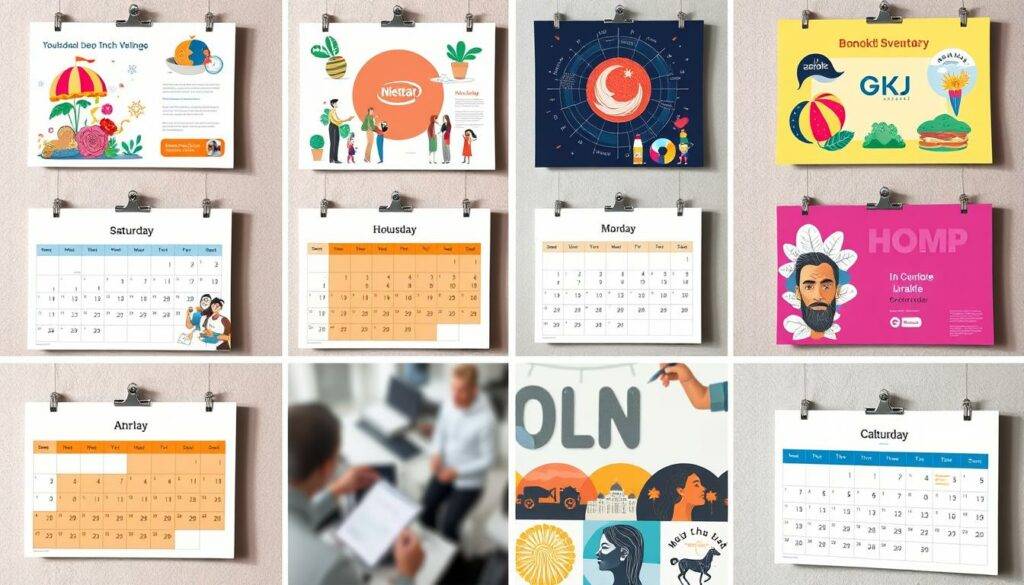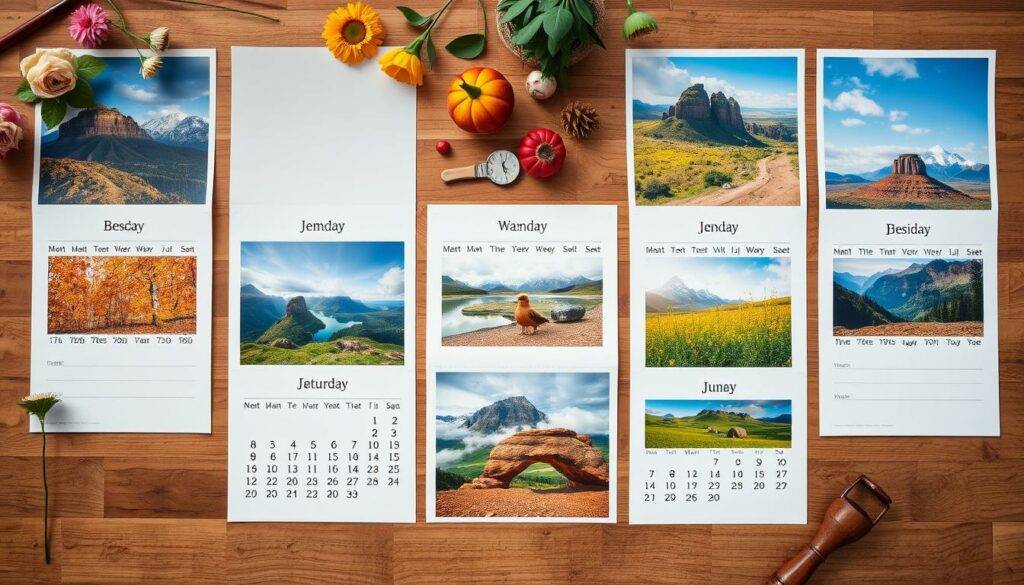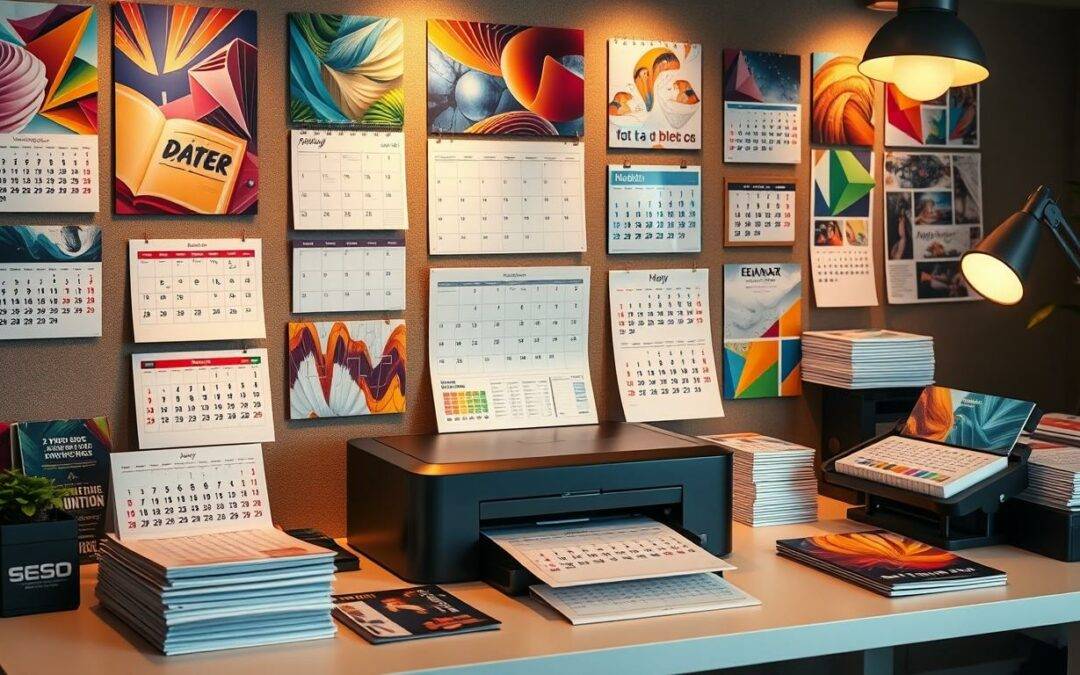Choosing the right calendar can make a big difference in how good it looks and works. Before picking a calendar, it’s key to know that many factors matter. These include the format, size, design, and material. Each one has its own special qualities that fit different needs and people.
This section will help you plan your calendar well. This way, you’ll be ready for a great print experience.
Key Takeaways
- Understanding the significance of planning for calendar printing.
- Exploring different calendar formats to meet your needs.
- Considering the size of the calendar for better functionality.
- Importance of design elements to enhance visual appeal.
- Evaluating materials and finishes for durability and look.
- Understanding the eco-friendly options available in calendar printing.
Understanding the Importance of Calendar Options
Choosing the right calendar is key for both personal and business use. Calendars do more than just mark days; they can also be powerful branding tools. A well-designed calendar helps manage time and boosts audience engagement.
Effective calendars meet the needs of their users. Features like customizable layouts and reminders make calendars valuable. Personalizing calendars makes them more appealing and useful.
In short, the right calendar options boost efficiency for individuals and businesses. Recognizing the value of calendars helps businesses connect and make lasting impressions.
Popular Calendar Formats for Printing
Choosing the right calendar format can really help with planning and staying organized. Each type has its own charm, meeting different needs and tastes. This affects how people use their calendars.
Wall calendars are known for their big pictures and lots of room for notes. They hang in offices, homes, or public areas. They’re great for families or teams to keep everyone’s schedule in sync.
Desk calendars are perfect for those who need a daily planner. They’re small and sit on desks or personal spaces. They make it easy to flip to today and have space for jotting down reminders. Many people like them because they’re stylish and useful.
Planners and pocket calendars are also favorites for staying organized on the move. Planners have lots of space for detailed plans, perfect for students or busy professionals. Pocket calendars are small but pack a punch, letting you keep track of dates easily, no matter where you are.
- Wall Calendars: Great for group visibility and organization.
- Desk Calendars: Perfect for personal use and daily planning.
- Planners: Excellent for in-depth scheduling.
- Pocket Calendars: Ideal for portability and quick access.
Knowing about these different calendar types helps pick the best one for you or your audience. It boosts productivity and helps manage time better.
| Calendar Type | Best For | Key Features |
|---|---|---|
| Wall Calendars | Group use | Large visuals, ample space for notes |
| Desk Calendars | Personal use | Compact design, easy date access |
| Planners | Detailed scheduling | Extensive layout, sections for notes |
| Pocket Calendars | Portability | Small size, quick date references |
Choosing the Right Calendar Size
Choosing the right size for a calendar is key in design. The right size can make it look good and work well. You need to know standard sizes and why custom sizes are good for special needs.
Standard Sizes You Should Know
Standard calendar sizes are popular because they’re easy to use. Here are some common ones:
- 8.5” x 11” (Letter)
- A4 (8.3” x 11.7”)
- 12” x 12” (Square)
- 11” x 17” (Tabloid)
These sizes work well for most uses. They make printing and showing easy. They also help keep designs simple.
Custom Size Considerations
Choosing custom sizes can help meet special needs. Think about these points for custom sizes:
- Space utilization: Pick a size that fits well without being too big.
- Visual impact: A unique size can grab more attention and be remembered.
- Cost considerations: Custom sizes might cost more to print, so think about your budget.
By thinking about these points, you can choose sizes that are both useful and look good.
Design Elements to Enhance Your Calendar
Adding thoughtful design elements can make your calendar stand out. Choosing themes for calendars and color schemes for calendars lets you personalize it. Themes can set the mood, and colors can send messages and grab attention.
Selecting a Theme
The theme of your calendar is key to its design. You might want a professional look or something fun and artistic. It’s important to pick a theme that your audience will love. Some popular themes include:
- Nature and landscapes
- Inspirational quotes
- Abstract art
- Seasonal or holiday motifs
- Corporate branding
Color Scheme Choices
Colors can greatly impact how your calendar is seen. Each color can evoke different feelings. Choosing the right colors is crucial. Here are some good color combinations:
| Color Combination | Emotion Evoked | Recommended Use |
|---|---|---|
| Blue and White | Calm, Professional | Corporate Calendars |
| Red and Gold | Energetic, Festive | Holiday Themes |
| Green and Earth Tones | Relaxing, Natural | Nature Themes |
| Pastel Palette | Soft, Inviting | Creative or Artistic Calendars |
Calendar Options for Different Audiences
Creating calendars for businesses needs focus on being professional and useful. These calendars list important dates and events for the corporate world. They should have clean designs, organized layouts, and colors that are business-like.
Custom branding makes these calendars stand out. It shows off a company’s image while helping employees and clients stay organized.
Personal calendars, however, are all about creativity and personal touch. They let users add photos, quotes, and special moments. This makes them more than just a calendar; they become a keepsake.
Using bright colors and themes that match personal tastes is key. This makes personal calendars a reflection of who we are.
Targeted calendar designs are vital for meeting different needs. Knowing what your audience likes can make your calendar more appealing. For example, a student calendar might focus on school schedules and holidays.
A family calendar could list everyone’s important events. Tailoring designs to fit specific groups makes calendars more useful and wanted.
Incorporating Branding in Calendar Design
Branding calendars are a great way to make your company more visible. They help create lasting impressions by using logos, colors, and images that match your brand. This makes your brand stand out and connect better with people.
Calendars with your brand on them are useful all year. They keep your brand in customers’ minds. Seeing your logo and colors often helps people remember your brand better.

- Logo Placement: Make sure your logo is easy to see, especially on the cover and at the top.
- Color Consistency: Stick to your brand’s colors to keep the design looking good.
- Imagery: Choose images that show what your brand is about or highlight your products.
- Messages: Add quotes or messages that match your brand’s mission and appeal to your audience.
Here’s a table to show how different branding elements affect visibility in calendars:
| Branding Element | Visibility Impact | Examples |
|---|---|---|
| Logo | High | First page, footer |
| Color Palette | Medium | Monthly themes |
| Imagery | Medium | Product showcases |
| Motivational Quotes | Low | Monthly highlights |
Adding these elements to your calendar makes it look better and strengthens your brand. It keeps your brand in people’s minds every day of the year.
Materials and Finishes for Calendars
Choosing the right materials and finishes for calendars is key. It affects both how they look and how long they last. Understanding the options for paper types is crucial for a calendar that looks good and lasts.
Paper Types
There are many paper types for calendars, each with its own charm. Here are some popular ones:
- Glossy Paper: It brings colors to life, ideal for bold designs.
- Matte Paper: It has a smooth finish that reduces glare, great for simple yet elegant designs.
- Recycled Paper: It’s good for the planet and still looks great, perfect for those who care about the environment.
- Textured Paper: It adds a special touch, making the calendar feel unique.
Finishing Options
Finishes for printing are just as important as the paper. They can make or break the calendar’s look. Here are some popular finishes:
- Lamination: It keeps the calendar safe and shiny.
- Binding Options: Choices like spiral binding or saddle-stitching make pages easy to turn while keeping things neat.
- Foil Stamping: It adds a metallic sheen, making the calendar stand out.
- Embossing: It creates a raised effect, adding depth and texture to designs.
Calendar Options for Eco-Friendly Printing
More people want green calendars now because they care about the planet. These calendars use materials that are good for the environment. By choosing eco-friendly calendars, companies show they care about the planet too.
Using sustainable printing is key for these calendars. They use recycled paper and safe inks to cut down on pollution. Also, picking local printers helps the environment and supports local businesses.
Here are some materials to use for your eco-friendly calendar:
- Recycled paper
- Biodegradable inks
- Varnish or gloss finishes made from natural resources
It’s important to reduce waste in printing too. This means printing only what you need, using digital proofs, and avoiding extra prints. These steps make green calendars more appealing to those who care about the planet.
By focusing on eco-friendly calendars, brands attract customers who value the environment. This helps companies build a loyal customer base.
How to Utilize Photography in Calendars
Using photos in calendars is a great way to grab your audience’s attention. It makes the calendar look better and tells a story. Choosing the right photos for each month is key.
Think about using pictures that show off the seasons or big events. This makes the calendar more interesting and personal. It helps people connect with it all year long.

- Choose High-Resolution Images: Make sure all photos are clear and sharp for the best prints.
- Relate Images to Themes: Pick photos that match the theme of each month to add depth to the story.
- Focus on Diversity: Mix up the subjects to keep the calendar visually appealing.
- Storytelling Through Pictures: Use your photos to tell stories or share feelings to connect with viewers.
Using photos well in calendars makes them beautiful and tells a story. It invites people to enjoy and remember each month in special ways. By focusing on these tips, your calendars can become treasured pieces that inspire and delight.
| Best Practices | Description |
|---|---|
| High-Resolution Images | Use images that maintain clarity and detail when printed. |
| Month-Related Themes | Select photos that embody the spirit of each month. |
| Diverse Subjects | Incorporate a variety of images to keep interest high. |
| Emotional Storytelling | Create connections through images that tell a story. |
Budgeting for Your Calendar Project
Effective calendar project budgeting is key to success. It helps you find cost-effective printing and avoid hidden costs. Here are some tips to help you budget better.
Cost-Effective Printing Tips
- Research local printers to compare prices and services.
- Consider using online printing services for competitive rates.
- Order in bulk to take advantage of volume discounts.
- Choose standard sizes to minimize custom setup fees.
- Evaluate paper types that balance quality and cost, such as matte or glossy finishes.
Potential Hidden Costs
When planning your calendar printing, watch out for hidden costs:
- Shipping fees can add up quickly, especially for bulk orders.
- Design fees incurred by hiring professionals or purchasing graphic designs.
- Setup fees related to printing configurations and custom elements.
- Tax implications based on printing location.
- Potential costs for revisions or changes during the proofing process.
| Cost Item | Estimated Cost |
|---|---|
| Basic Printing Cost (per unit) | $1.50 |
| Shipping | $30.00 |
| Design Fees | $200.00 |
| Setup Fees | $50.00 |
| Total (for 100 calendars) | $380.00 |
Understanding these points helps you budget well. It lets you manage costs and avoid surprises. You can also achieve your creative vision.
Calendar Options to Consider Before Going to Print
Before you start printing calendars, it’s important to make smart choices. A detailed pre-print checklist helps make sure your calendar meets your expectations. First, look at different formats and sizes to find the best fit for your audience.
Design is key to your calendar’s appeal. Choose a theme and colors that match your brand and audience. These should work well together, making your calendar look great.
Branding is also crucial. Add your logos and brand elements to make your calendar memorable. It turns your calendar into a promotional tool, not just a timekeeper.
The material you choose affects your calendar’s look and feel. The right paper and finish can make it last longer and look better. Remember to budget for printing, including any extra costs. This way, your project stays within budget and looks amazing.
By carefully choosing your calendar options, you’re set for a successful project. With a solid checklist, you can focus on every detail of design and production.
Conclusion
As we conclude, it’s key to think about the calendar options we’ve covered. Choosing the right calendar involves many factors. These include formats, sizes, design, and what your audience likes.
Every choice you make affects how people will use and enjoy your calendar. This makes each detail very important for a great product.
Using eco-friendly materials, adding your brand, and picking the best materials make your calendar look good. They also show you care about the planet and your brand. Remember, think about who will use your calendar. This way, it will be useful and meaningful to them.
In the end, our advice is to use what you’ve learned to make calendars that really make an impact. With good planning and creativity, you can create a calendar that’s not just useful but also beautiful. It will share your message all year long.
FAQ
What are the key factors to consider when choosing a calendar format?
When picking a calendar format, think about its purpose and who it’s for. Also, consider the design elements that will best share your message. You might choose wall calendars, desk calendars, or planners, each with its own use.
Why is it important to choose the right size for a calendar?
The size of your calendar matters for its look and use. Standard sizes like 8.5″x11″ and A4 fit most needs. But, custom sizes can make your calendar fit specific marketing goals or personal uses.
How can I enhance my calendar’s design and make it more appealing?
To make your calendar stand out, pick a theme and a color scheme that works. Use colors that match your brand and make people feel something.
How can I ensure my calendar appeals to a特定 audience?
Make your calendar design and features match your target audience. For example, business calendars should look professional. Personal calendars can be more creative and customizable.
What role does branding play in calendar design?
Branding is key because it makes your brand more visible and connects with your audience. Use logos, brand colors, and images that fit your brand to make your calendar a great marketing tool.
What materials should I consider for my calendar?
Calendars can be made from many materials, like glossy, matte, or recycled paper. Each material changes the calendar’s quality and how long it lasts. So, picking the right one is important.
Are there eco-friendly options for calendar printing?
Yes, there are eco-friendly printing options like using recycled paper and non-toxic inks. Choosing these options can help reduce waste and appeal to people who care about the environment.
How can photography be utilized effectively in a calendar?
Great photography can make your calendar more engaging by telling a story. Choose images that match each month or theme to keep people interested and create a connection.
What budgeting tips can help me manage costs for my calendar project?
To manage costs, look for affordable printing options and choose the right printer. Be aware of extra costs like shipping and design fees. Planning carefully will help you stay on budget and get quality results.
What should I include in a pre-print checklist for my calendar?
Before printing, check the format, size, design, branding, materials, and budget. A detailed checklist will ensure your calendar project is a success.




